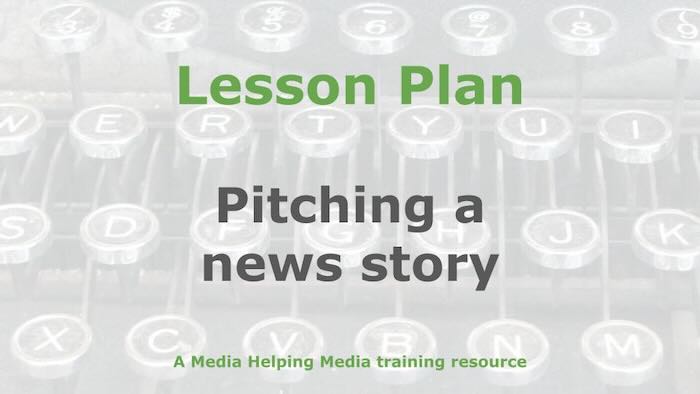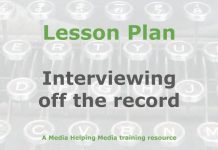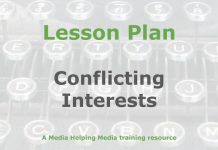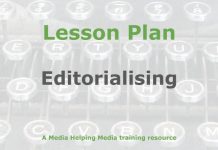 This lesson plan provides a comprehensive guide to the essential skill of pitching a news story idea to an editor.
This lesson plan provides a comprehensive guide to the essential skill of pitching a news story idea to an editor.
It’s based on the article ‘Pitching a news story to an editor‘ which we recommend trainers read before adapting this material for your own purposes.
Introduction: why pitching matters
Welcome to this lesson on one of the most vital skills in journalism: successfully pitching a news story to an editor. Whether you are a freelancer or a staff reporter, your story only reaches its audience if you can first convince a busy editor of its value.
Senior editorial staff are constantly swamped with story ideas from correspondents, wires, social media, and by monitoring competitors. Your pitch must therefore be strategic, clear, and compelling to stand out.
The principles you will learn today are distilled from decades of journalistic experience.
The goal of this lesson is to equip you with the strategic planning, practical techniques, and mindset necessary to significantly increase the chances of your news story being accepted.
Timetable and session details
9:00 – 9:30 (30 mins): Introduction: why pitching matters
Activity: Overview of the lesson, discussion of the editor’s perspective (busy and swamped), and introduction to the four core steps of pitching. We will review the core concepts based on the associated article ‘Pitching a news story to an editor‘.
9:30 – 10:30 (60 mins): Session 1: know your target publication and audience
Step 1: Before writing a pitch, you must know your target.
- Absorb everything: You must consume every edition or broadcast. This helps you understand what is current, what the outlet focuses on, and what stories need a follow-up.
- Identify the target audience: Figure out who their readers/viewers are. What appeals to them? A successful pitch directly addresses the needs and interests of this audience.
- Spot gaps in coverage: This is critical. Look for what the publication is not covering. If a newspaper covers what councillors say but not the general public’s reaction that is a gap you can fill with an original pitch.
Activity: Participants, in groups, select one major news outlet (e.g., The Guardian, CNN, BBC). They spend 30 minutes analysing its content to determine its target audience, its house style, and three potential gaps in its recent coverage.
10:30-10:45 (15 mins): Break
10:45 – 12:00 (75 mins): Session 2: developing a timely, original, and relevant story idea
Step 2: Your story must demonstrate “news sense” and offer something new.
- Be timely (current): Your story must be about a current topic or reference ongoing discussions or recent events. A story that was relevant last week is a missed opportunity.
- Offer a new angle (original): Editors hate rehashed news. You need a fresh perspective. This is often achieved by following up on a current, broad story to reveal a new, highly specific angle.
- Include people: Stories about policies or events are important, but stories that include people – especially those affected by the issue – are often more attractive. Human interest adds depth, emotional appeal, and audience connection.
Activity: The class is given three major, national news headlines. Individually, participants must devise one specific, local, or human-interest angle for each story that would be original to the target publication they analysed in Session 1.
12:00 – 1:00 (60 mins): Lunch
1:00 – 2:00 (60 mins): Session 3: crafting the perfect pitch
Step 3: The pitch itself must be clear, compelling, and efficient.
- Write in the publication’s style: While sub-editors will polish the final article, a pitch written in the outlet’s house style shows you understand their standards and makes their job easier.
- Make it concise: Senior editorial staff are busy. The pitch (ideally an email) should be short – no more than a few focused paragraphs – and immediately convey the story’s value. Get to the point in the first sentence.
- Explain the appeal: You must explicitly state why the story would appeal to the news outlet’s target audience, linking it back to the gaps you identified in their regular coverage.
Activity: Using one of the original angles developed in Session 2, participants draft a full, concise email pitch (approx. 200 words) addressed to a hypothetical editor. The pitch must include a strong subject line, a clear summary of the story, and a sentence explaining its relevance to the outlet’s audience.
2:00 – 2:45 (45 mins): Session 4: show persistence and initiative
Step 4: Persistence builds a professional reputation.
- Don’t give up: Rejection is a fundamental part of journalism. Continuing to provide relevant, well-researched pitches, even after a knock-back, is essential. Each rejection is a chance to refine your approach.
- Initiative: Finding an original story, doing the groundwork, and delivering clean copy (even if it needed editing). Persistence and a “nose for news” will impress editors.
- Professional follow-up: Understand the difference between persistence and nuisance. A polite, brief follow-up email after a few days is acceptable; daily calls are not.
Activity: Role-playing. Participants pair up. One acts as a busy editor, the other as a reporter pitching a story. The editor initially rejects the pitch with vague feedback. The reporter must then professionally follow up with a refined, stronger argument.
2:45 – 3:00 (15 mins): Summing up
Successfully pitching a news story is a strategic process that involves four key steps:
- Know your target: Research the publication and its audience to find coverage gaps.
- Develop the idea: Ensure the story is timely, original, and features a strong human element.
- Craft the pitch: Make it concise, write in the publication’s style, and clearly state the audience appeal.
- Show persistence: Never be disheartened by rejection; use it to build a strong professional reputation through consistent quality.
By mastering these steps, you demonstrate that you have the required news sense and professionalism to deliver value to any editorial team.
3:00 – 4:00 (60 mins): Assignment: the perfect pitch
Scenario: A major regional government has just announced a new policy to restrict water usage due to a multi-year drought. The local publication you are targeting is currently running front-page stories on the political fallout and the general economic impact.
Task:
- Find the gap (Step 1): Based on the general news coverage described, identify a specific, people-focused gap in the current reporting that an editor would find appealing.
- Develop the angle (Step 2): Create a story idea that is timely, original, and includes a specific group of people affected (e.g., small business owners, specific neighbourhood residents, etc.).
- Draft the pitch (Step 3): Write a full pitch email (200-250 words) to the editor for this story, ensuring it is concise and explains why your angle will appeal to the publication’s primary target audience.
- Plan the follow-up (Step 4): Outline a one-paragraph professional follow-up strategy in case you do not hear back after 48 hours.
4:00 – 4:15 (15 mins): Conclusion and next steps
Activity: Final thoughts, summary of key takeaways, resources for further learning, and lesson wrap-up.
Conclusion
We have spent the day dissecting the art and strategy of pitching. Remember the successful pitch, whether delivered in an envelope in 1976 or a concise email today, hinges on the same foundational pillars: research, originality, clarity, and persistence.
You now have the tools and framework to approach editors not just with an idea, but with a fully strategised proposal that fits their needs, appeals to their audience, and demonstrates your professional value.
Related material








